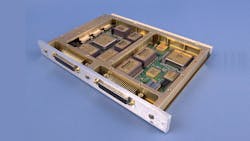Triple-Modular Space Computers Will Help Trace Origin of the Milky Way
Boasting a proprietary system-level architecture and component-shielding technology, seven single-board computers will provide processing power for the European Space Agency’s (ESA) Gaia satellite. The Maxwell SCS750 space computers, which will be incorporated into the satellite’s video processing unit (VPU), will process images and data gathered by the satellite’s two telescopes and billion-pixel digital camera. This information will help scientists create a 3D map of the Milky Way galaxy, helping to trace its origin and evolution.
To ensure that the computer can withstand the effects of environmental radiation encountered in space, the SCS750 is built with silicon-on-insulator (SOI) processors. It also integrates Actel’s RTAX-S radiation-tolerant field-programmable gate arrays (FPGAs) and the RAD-PAK and RAD-STACK packaged memories. The board is expected to perform at optimum level for 100 years in low Earth orbit (LEO) or geostationary (GEO) orbit.
If one processor malfunctions, the computer will continue to function uninterrupted, thanks to a triple-modular redundancy architecture. Essentially, three commercial IBM PowerPC 750 processors run the same program simultaneously and “vote” on each operation. Should a processor begins reading errors, it will be isolated and put in reset mode to eradicate lag time. The software is adjustable, which allows it to meet mission needs with scrubbing performed periodically.
Maxwell claims that its computer is capable of 1000x better performance than the space processor boards that are currently used. It operates 24/7 to help the satellite observe and record the motion, brightness, temperature, and composition of a billion or more stars 70 times each during the five-year mission. The Gaia satellite, which was launched in December 2013, was developed by European aerospace companies and Airbus Defense and Space France (formerly known as Astrium). ESA officials hope that the information gathered by the satellite will positively impact astronomy to the extent that weather satellites benefited meteorology.
About the Author
Iliza Sokol
Associate Content Producer
Iliza joined the Penton Media group in 2013 after graduating from the Fashion Institute of Technology with a BS in Advertising and Marketing Communications. Prior to joining the staff, she worked at NYLON Magazine and a ghostwriting firm based in New York.
